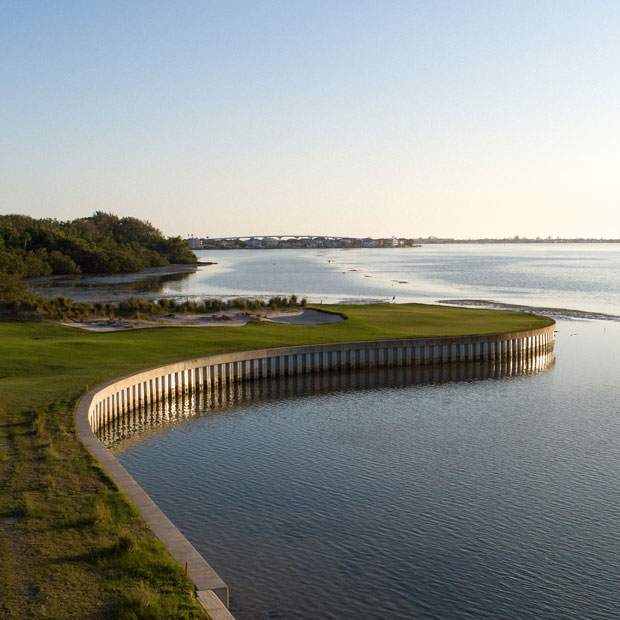The Bunker That Changed Golf: No. 4 at Woking
The origins of strategic golf course design at Woking Golf Club


Much of history is quite boring. This happened, which led to that, and on and on. But the most exciting parts of history are the clear and unexpected turning points. It’s fun when we can point to one moment, one person, or, in this case, one bunker that changed everything.
This is the story of Woking Golf Club, which started life in 1893 in Surrey, England, with a fairly dull design by Tom Dunn, an architect of the penal school of golf course design. This isn’t meant as an insult to Dunn; the penal school was basically the only one available to him. Up until then, golfers and golf course designers assumed that the sole purpose of a hazard was to penalize a wayward shot.
At the time of Woking’s opening, golf was played primarily near the ocean. The natural and rugged terrain of the seaside links paired with ideal soil and turf to make for the most functional and interesting golf courses. It took years for suitable inland courses to be built, and Woking was among the first major wave. Inland courses were inferior for several reasons, but mainly because they tended to be boring. The beauty and natural contour of the links brought excitement and strategy even before golfers understood why. Inland settings and penal design led to dull, second-rate golf. But this state of affairs began to change when two members of Woking Golf Club decided to take matters into their own hands. Those members were John L. Low and Stuart Paton.

Two Men and a Shovel
The original par-4 fourth hole at Woking was straightforward, with a wide fairway that bordered train tracks on the right and a cross bunker in front of the green. In 1901, without telling anyone of their plan, John Low and Stuart Paton dug a pair of bunkers in the center of the fairway, inspired by the famous Principal's Nose bunker complex on the 16th hole at St. Andrews. They also added bunkers at the front-left portion of the green. Combined with a green sloping from front-left to back-right, these new bunkers turned Woking's fourth hole into an exemplar of strategic design.

The player has two options: take the aggressive line between the centerline bunkers and the out-of-bounds line in pursuit of the ideal angle of approach, or bail out left of the bunkers, leaving a difficult second shot over the green-side bunkers and down the tilt of the green.
This type of design was a first for inland golf. Rather than simply punishing the poor player for mishits, the hazards on Woking's fourth hole now enticed the better golfer to take a risk for a potential reward.
Still entrenched in the penal philosophy of design, members of Woking were quite angry about the changes to No. 4. But Low stood firm, defending his ideas in many essays on the topic.
It’s easy to see why many would be confused by Low's ideas. The principles of penal design conform with common sense: the worse the shot, the greater the punishment. Simple. The new fourth hole at Woking seemed to defy this logic of justice. Instead of an immediate penalty, it exacted a delayed penalty. If you take the easy route to the left, you won't receive your punishment right away. Only when you reach your ball will you realize how dead you are.
A Movement Begins
In 1905, Low assisted St. Andrews in adding strategic bunkering to challenge players who had gained length with the use of the new Haskell ball. These changes were not well-received, and again Low took the heat. Many had a hard time giving up the “logical” system of penal design, feeling that bad shots needed to be punished more than almost-good ones. Low's bunkers, critics said, were "unfair." (This debate should sound familiar to anyone keeping track of golf discourse today.)
But Low would not be swayed. He had spent a great deal of time on the classic Scottish links. From this experience, he knew that the best golf courses were not necessarily logical or fair. Irrationality and chance, he believed, were critical to the essence of the game. So the purpose of a hazard was not to deal out just punishment for ball-striking crimes. It was to make the game more exciting and sophisticated, more engaging to the intellect. As Low once wrote, “The true hazard should draw play towards it, should invite the golfer to come as near he dare to the fire without burning his fingers.” According to this argument, there was no such thing as an unfair bunker.
By 1906, influential golf writer Garden Smith said that Low’s principles had won out, and that a new era of golf course design had begun. Low's claim that no bunker can really be unfair had found broad acceptance. His and Paton's alterations to Woking also showed that inland golf could be just as interesting as the links game.
So if you are searching for the moment that modern golf course design started, look no further than the installation of the centerline bunker on the fourth hole at Woking. As architect Tom Mackenzie put it, “Woking represents a turning point in the development of golf course architecture. For that reason, it is a landmark course well-known to all architects across the globe.”

After-Effects
Low and Paton's work at Woking influenced many golf architects, including Charles Hugh Alison (known in the U.S. for his work at Pine Valley and his original designs at Milwaukee, Kirtland, and the Country Club of Detroit) and Tom Simpson.
According to legend, Simpson went to Woking on a rainy day and heard others in the clubhouse complaining about the new bunker on the fourth hole. Simpson decided the rain wouldn’t stop him from examining the hole. Seeing it, he had something of an epiphany about strategic design. He returned to the clubhouse wet and smiling, and soon he resolved to start designing courses himself.
Simpson later wrote, “It is only the mad masterpieces that remain in the memory." The fourth hole at Woking, presumably, was one such mad masterpiece.

The 21st century has seen a resurgence in strategic golf course design, spearheaded by the likes of Bill Coore and Ben Crenshaw, Tom Doak, and Gil Hanse. Like anything else, though, trends in golf architecture wax and wane. The cliché is true: history repeats itself. Today, strategic architecture seems dominant; tomorrow, the simple-seeming logic of penal design may stage a comeback. But with the fourth hole at Woking standing as an example, the hope is that John Low's principles will never disappear entirely. As Doak once said, “For anyone who really wants to be a golf architect, I heartily recommend Woking as one of the most rewarding courses in the world you can see.”
Leave a comment or start a discussion
Engage in our content with thousands of other Fried Egg Golf Club Members
Engage in our content with thousands of other Fried Egg Golf Members
Get full access to exclusive benefits from Fried Egg Golf
- Member-only content
- Community discussions forums
- Member-only experiences and early access to events











Leave a comment or start a discussion
Lorem ipsum dolor sit amet, consectetur adipiscing elit. Suspendisse varius enim in eros elementum tristique. Duis cursus, mi quis viverra ornare, eros dolor interdum nulla, ut commodo diam libero vitae erat. Aenean faucibus nibh et justo cursus id rutrum lorem imperdiet. Nunc ut sem vitae risus tristique posuere. uis cursus, mi quis viverra ornare, eros dolor interdum nulla, ut commodo diam libero vitae erat. Aenean faucibus nibh et justo cursus id rutrum lorem imperdiet. Nunc ut sem vitae risus tristique posuere.